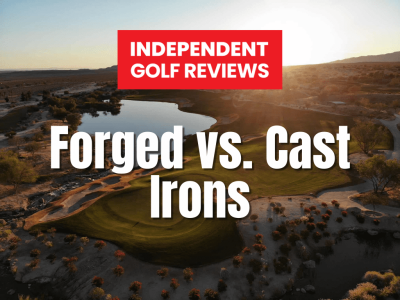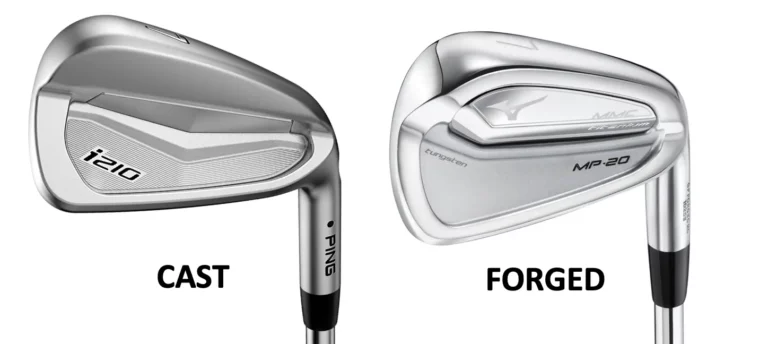- Updated: April 6, 2023
Forged vs. Cast Irons
A forged iron is made using a singular block of solid metal that’s heated red hot, stretched, hammered, formed to the iron’s specific head shape, and cooled. A cast iron golf club’s head is made by pouring liquid metal into a mold of the desired shape.
By using a liquified metal in the cast iron creation process, club head engineers and designers are able to be more aggressive in the “game improvement iron” head shapes leading to more forgiving “cavity back style” designs in the cast iron genre of club head.
This could be why we often recognize forged irons as the “better players clubs.” (Less game-improvement style head shapes)

What's the Difference Between Forged and Cast Irons?

The main differences between forged and cast iron golf clubs are the physical manufacturing processes involved, head shape designs, and primarily the feeling the clubs give users after a strike.
Forged Irons Key Differences
The metal used to create forged irons is heated to extreme temperatures to be formed and shaped, but it is always a solid throughout the entire process. The metal is actually heated and compressed multiple times in the forging process before reaching its final shape. All this pressure and heat put into a forged iron head during production enhances the metal’s molecular structure, making it much tighter and more consistent.
By maintaining the solid state of the metal used to create forged irons throughout the process, the metal’s strength, integrity, and consistency throughout the club head are held to higher standards than that of cast club head alternatives.
In addition to creating higher levels of strength and consistency through the forging process, club head manufacturers are also able to control the “grain flow direction” of the metal (unlike cast irons where there is no “grain flow” due to using liquid metal in the beginning).
The nature of creating forged heads generally requires a softer metal to be used. This results in club heads that can have their lofts and lies bent and adjusted after purchase for further specific player customization. The softer metal used and consistent grain direction explains the long-standing idea that “forged clubs feel softer” and/or “better” than cast clubs. This dependable grain direction and forging process results in forged club heads having a better feel to users off the club face after striking the ball with longer and more accurate vibrational feedback to players’ hands.
Looking at the photo of the two Titleist forged club heads above, you’ll likely notice their sleek and smaller head shapes. Since forged iron heads are created by hand and not by pouring liquid metal into a mold, the head shape of forged clubs is usually smaller than cast irons and in a blade, muscle back, or very shallow cavity back design. This is likely why forged irons head designs have mostly stayed the same over the years, while cavity back iron designs change year after year.
Forged irons have consistently had smaller head shapes, thinner, more intimidating top lines, and smaller, less forgiving soles, making many forged irons harder to hit for players unconfident in their ball-striking abilities.
Forged irons substitute the extra distance and forgiveness on poor strikes cast (game improvement style) clubs have for additional feel, adjustability after purchase, and often more ability to work the ball in different directions or at different trajectories.
Golfers looking to “progress with a set,” or as their ball-striking skills improve, want their clubs to improve with them, should consider forged irons.
Cast Irons Key Differences
Cast irons manufacturing process starts by pouring liquid molten metal into a mold of the desired club head shape. Unfortunately, when the liquified metal cools and hardens to its wanted shape, slight shrinkage and distortion is happening to the metal. Small air holes form in the metal, resulting in inconsistency in the material and a downgraded “feeling” to the hands of users when directly compared to forged iron counterparts.
That isn’t to say the casting process is entirely bad! The process of casting irons has gotten exponentially better within the last 15 years, with top-ranking wedge manufacturers like Titleist’s Vokey and Cleveland casting their club heads. Due to using a mold instead of creating the heads by hand, cast irons have much more variability in head shape design than forged irons.
Club engineers can be more specific with perimeter weighting and often have cavities for polymer inserts and other technology to be put in the club head to boost forgiveness, distance, or feel. This results in a larger size of the sweet spot in cast irons compared to the sweet spot size in forged irons, meaning substantially more ease of use for players on off-center strikes.
The size of the sweet spot and the forgiving nature of cast irons result in off-center strikes closer to the intended distance than an off-center strike with a forged iron. Unfortunately, due to the nature of a cast club and the minor imperfections that can occur during the creation process, cast club’s distances are less predictable from one solid strike to the next. Where a forged club hit in the center of the face at “100%” will always travel a repeatable and consistent carry distance, cast irons have less reliable predictability.
Additionally, since a cast club isn’t made by hand like the forged club, cast clubs are generally always less expensive than forged.
Cast irons almost always have larger heads, more forgiving soles, and thicker, more confidence inspiring top-lines. This likely explains the long-standing idea that most cast irons are for the more beginner players that could see substantial benefits from the larger face and head profile, larger and easier to get through the turf sole, and distance boosting aspects.
We tend to agree that many beginners and mid-handicappers who could benefit from the distance, forgiveness, and game improvement technology cast irons offer should play them.
Pros and Cons of Forged Irons
Pros:
1. Look and “Feel” – Objectively, forged irons are more aesthetically pleasing to look at than most all cast irons. Elite players love the sleek and simple look forged irons provide behind the ball and use the “feel” (the feedback given to player’s hands during and after contact) forged irons give to accurately and precisely judge yardages and the amount they want to have the ball move in a specific direction during the shot.
2. Construction Process – The forging process used to create forged clubs results in much tighter and more consistent metal in the club heads. This ultimately leads to the “buttery smooth feel” forged irons are known for.
3. After Purchase Customization – Players that enjoy experimenting or tinkering with their clubs to find the best possible ball striking conditions can have their loft and lie angles modified by having forged clubs. The softer metal of forged irons is much easier to bend and adjust than cast irons. Cast irons have much less tolerance to being modified from their original “sold as” form.
4. Shot Shaping Capability – Since forged irons generally have smaller, less “game improvement” style head shapes that aren’t explicitly focused on hitting the ball further and straighter, players often have a greater ability to change the height or direction of the ball flight for more precision.
5. Consistent and Reliable Distance Control – Forged irons have much more repeatable distance control from center strikes than cast irons.
Cons:
1. Cost – The forging process is completed by hand, requiring more effort, expertise, and money to complete club heads for consumers. This makes forged irons cost more than cast iron counterparts.
2. Generally Less Forgiving (More Skill Required) – Since forged iron’s head shapes are usually smaller with less game-improvement irons technology built into their design, forged irons are considered less forgiving on off-center strikes than cast irons. With a smaller sweet spot comes a large amount of lost yardage on poorly struck balls and awful feeling feedback to players’ hands.
Pros and Cons of Cast Irons
Pros:
1. Cost – Cast irons are created using molds and molten metal, a much less expensive process than forging clubs from a solid piece of metal. The results are that cast irons are less costly than forged irons.
2. Ease of Use – The sole is usually wider, the top line is generally thicker, and the club heads are almost always larger on a set of cast irons than forged irons. Beginner, intermediate, and mid to high handicappers who experience substantial benefits from these attributes should look toward cast and more game improvement irons.
3. Options of Head Shapes, Styles, and Technology – Cast irons have much more variability in head shape and design since their base material starts as a liquid and forms into the body of a mold. This means club head engineers can more precisely place exterior weight for enhanced forgiveness and offer many different styles of look, where many forged golf clubs look similar to forged clubs of long ago. Also, since club makers know cast irons have a worse feeling than forged clubs, they’ll often inject the head with a polymer or fix a plate of some kind to the club head cavity to improve the look, feel, and performance of the club.
Cons:
1. Feel and Feedback- Experienced players or any golfer paying strong attention to the feedback received after hitting the ball will notice a strong difference in feel and feedback to their hands after a strike when directly comparing a cast iron and forged iron head to head. The solid metal forged irons give more “precise” prolonged vibration after a strike and a more “pure” feel when struck solidly compared to cast irons.
2. Consistency – Forged irons are built to provide incredibly consistent and repeatable yardages and feel to consumers. With poor strikes, the yardage and feel on a forged iron is horrendous. Cast irons are built to provide increased forgiveness and distance at a lower cost to consumers. With poor strikes, the yardage might be better than forged irons, but with great strikes, the distance is often less predictable.
3. Ability to Adjust After Purchase – Most cast irons have far less ability to be bent and modified after purchase than forged irons due to their construction process. Softer forged irons stay a solid metal throughout their creation, whereas cast irons are a liquid metal, cooled to a solid. This process makes cast irons more subject to breaking than bending when tampered with. If you’re a player that enjoys tweaking their equipment’s lie angle and loft degree as their swing or skill level changes, you’ll have less success with cast irons than forged ones.
Is There a "Middle Ground" Between Cast and Forged Irons?
Within the last few years, golf equipment makers and engineers have begun experimenting with “Two-Piece” and “Multi-Material Construction” heads in iron sets. This construction style combines the forgiving aspects of cast iron designs like larger soles, thicker profiles, and even “hollow body” constructions (like shown above) with the buttery smooth feeling and more reliable distance control forged faces offer.
These clubs fit many golfer’s swings and intertwine more precise perimeter weighting from the cast body for more forgiveness with a forged face for an enormously improved feel and often enhanced ball speed.
Strong newer examples of this “two-piece” design are the TaylorMade P770s and the Ping i525s.
What Type of Golfer Should Play Forged vs. Cast Irons?
Suppose you’re a beginner, average golfer, or “game improvement feature” needing player who wants distance and forgiveness through size, more perimeter weighting, and added technology. In that case, you have endless options of cast irons to choose from. Additionally, you’ll be saving money by choosing cast irons over forged irons.
As your game improves and you start consistently striking the ball better, you might consider upgrading to a part-cast part-forged “Two-Piece” or “Multi-Material” style iron like the ones mentioned above. They’ll provide a better feeling and feedback to players’ hands than fully cast clubs with a less “game improvement style” head shape.
Unless you specifically seek out forged cavity back irons, most forged irons will be blade and muscle back styles generally reserved for great ball strikers who consistently and reliably find the center of the club face.
About The Author
Writers of Independent Golf Reviews
Independent Golf Reviews has tested and reviewed 1000+ golf products over the past 10 years. We use our experience and expertise to give golfers an unbiased insight on the market.
Read more…
Share
Receive the best golf discounts available exclusively for our subscribers and be auto entered into our monthly golf giveaways!
Success!⛳️
You are now an official member of IGR. Keep an eye out for the perks.
No spam, ever. 🔒

